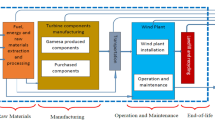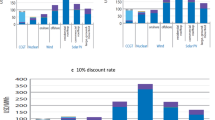Abstract
Purpose
Life cycle cost (LCC) considerations are of increasing importance to offshore wind farm operators and their insurers to undertake long-term profitable investments and to make electricity generation more price-competitive. This paper presents a cost breakdown structure (CBS) and develops a whole life cost (WLC) analysis framework for offshore wind farms throughout their life span (∼25 years).
Methods
A combined multivariate regression/neural network approach is developed to identify key cost drivers and evaluate all the costs associated with five phases of offshore wind projects, namely pre-development and consenting (P&C), production and acquisition (P&A), installation and commissioning (I&C), operation and maintenance (O&M) and decommissioning and disposal (D&D). Several critical factors such as geographical location and meteorological conditions, rated power and capacity factor of wind turbines, reliability of sub-systems and availability and accessibility of transportation means are taken into account in cost calculations. The O&M costs (including the cost of renewal and replacement, cost of lost production, cost of skilled maintenance labour and logistics cost) are assessed using the data available in failure databases (e.g. fault logs and O&M reports) and the data supplied by inspection agencies. A net present value (NPV) approach is used to quantify the current value of future cash flows, and then, a bottom-up estimate of the overall cost is obtained.
Results and discussion
The proposed model is tested on an offshore 500-MW baseline wind farm project, and the results are compared to experimental ones reported in the literature. Our results indicate that the capital cost of wind turbines and their installation costs account for the largest proportion of WLC, followed by the O&M costs. A sensitivity analysis is also conducted to identify those factors having the greatest impact on levelized cost of energy (LCOE).
Conclusions
The installed capacity of a wind farm, distance from shore and fault detection capability of the condition monitoring system are identified as parameters with significant influence on LCOE. Since the service lifetime of a wind farm is relatively long, a small change in interest rate leads to a large variation in the project’s total cost. The presented models not only assist stakeholders in evaluating the performance of ongoing projects but also help the wind farm developers reduce their costs in the medium–long term.









Similar content being viewed by others
References
Bjerkseter C, Agotnes A (2013) Levelised costs of energy for offshore floating wind turbine concepts. Department of Mathematical Sciences and Technology. Norwegian University of Life Sciences, Norway
Castro-Santos L (2013) Metodología para la evaluación económica de parques eólicos offshore flotantes a través del análisis del coste de las fases de su ciclo de vida. PhD Thesis. Universidad de la Coruña, La Coruña Spain
Castro-Santos L, Diaz-Casas V (2014) Life-cycle cost analysis of floating offshore wind farms. Renew Energy 66:41–48
Davidsson S, Höök M, Wall G (2012) A review of life cycle assessments on wind energy systems. Int J Life Cycle Assess 17:729–742
Department of Energy & Climate Change (DECC) (2011) Decommissioning of offshore renewable energy installations under the Energy Act 2004. URN 10D/1025, DECC, London, United Kingdom
Det Norske Veritas (DNV) (2010) Design of offshore wind turbine structures. DNV-OS-J101, Norway
Dicorato M, Forte G, Pisani M, Trovato M (2011) Guidelines for assessment of investment cost for offshore wind generation. Renew Energy 36(8):2043–2051
Dinmohammadi F, Shafiee M (2013) A fuzzy-FMEA risk assessment approach for offshore wind turbines, International Journal of Prognostics and Health Management, 4:59–68.
EWEA (European Wind Energy Association) (2015) The European offshore wind industry—key trends and statistics. Available online: http://www.ewea.org
Fuller SK, Peterson SR (1996) Life cycle costing manual for the federal energy management program. U.S. Department of Energy, Washington, USA
Garrad Hassan GL (2013) A guide to UK offshore wind operations and maintenance. Scottish Enterprise and The Crown Estate, UK
Howard R (2012) Offshore wind cost reduction pathways project—simple levelised cost of energy model. The Crown Estate, London, UK
IRENA (International Renewable Energy Agency) (2012) Renewable energy cost analysis: wind power. Available at: https://www.irena.org
Kaiser MJ, Snyder B (2012) Offshore wind energy cost modelling: installation and decommissioning. Springer, London, UK
Krohn S, Morthorst P-E, Awerbuch S (2009) The economics of wind energy. European Wind Energy Association (EWEA), Belgium
Levitt AC, Kempton W, Smith AP, Musial W, Firestone J (2011) Pricing offshore wind power. Energ Policy 39(10):6408–6421
Madariaga A, de Alegría IM, Martín JL, Eguía P, Ceballos S (2012) Current facts about offshore wind farms. Renew Sust Energ Rev 16(5):3105–3116
Maples B, Saur G, Hand M (2013) Installation, operation, and maintenance strategies to reduce the cost of offshore wind energy. NREL/TP-5000-57403. National Renewable Energy Laboratory, Colorado, USA
Márquez FPG, Tobias AM, Pérez JMP, Papaelias M (2012) Condition monitoring of wind turbines: techniques and methods. Renew Energ 46:169–178
Massachusetts Clean Energy Center (2010) Port and infrastructure analysis for offshore wind energy development. Boston, USA
Metal Prices (2014) Metal index: steel and iron. Available at: http://www.metalprices.com/p/metal_index (accessed 18th May 2015)
Myhr A, Bjerkseter C, Ågotnes A, Nygaard TA (2014) Levelised cost of energy for offshore floating wind turbines in a life cycle perspective. Renew Energ 66:714–728
Nielsen P (2003) Offshore wind energy projects feasibility study guidelines. SEAWIND-Altener project 4.1030/Z/01-103/2001, Ver. 3.0. Aalborg, Denmark
Nilsson J, Bertling L (2007) Maintenance management of wind power systems using condition monitoring systems—life cycle cost analysis for two case studies. IEEE T Energy Conver 22(1):223–229
Nordahl M (2011) The development of a life cycle cost model for an offshore wind farm. Chalmers University of Technology, Gothenburg, Sweden
Oceaneering International (2010) ROV services rate schedule UK & Europe. Aberdeen, UK
Offshore Design Engineering Ltd. (2007) Study of the costs of offshore wind generation. Renewables Advisory Board and Department of Trade and Industry, UK
Renewable UK (2011) Offshore wind: forecasts of future costs and benefits. UK
Shafiee M (2015a) Maintenance logistics organization for offshore wind energy: current progress and future perspectives. Renew Energ 77:182–193
Shafiee M (2015b) Maintenance strategy selection problem: an MCDM overview. J Qual Maint Eng 21(4):378–402
Shafiee M (2015c) A fuzzy analytic network process model to mitigate the risks associated with offshore wind farms, Expert Systems With Applications, 42(4):2143–2152
Shafiee M, Dinmohammadi F (2014) An FMEA-based risk assessment approach for wind turbine systems: a comparative study of onshore and offshore. Energies 7(2):619–642
Shafiee M, Finkelstein M (2015) An optimal age-based group maintenance policy for multi-unit degrading systems. Reliab Eng Syst Saf 134:230–238
Tavner P (2013) Offshore wind turbines: reliability, availability and maintenance. The Institution of Engineering and Technology, London, UK
Tegen S, Lantz E, Hand M, Maples B, Smith A, Schwabe P (2013) Cost of wind energy review. NREL/TP-5000-56266. National Renewable Energy Laboratory (NREL), Colorado USA
The Crown Estate (2010) A guide to an offshore wind farm. London, UK
The Crown Estate (2011) Offshore transmission network feasibility study. London, UK
The Crown Estate (2012) Offshore wind cost reduction: pathways study. Finance work stream, London, UK
Thomson RC, Harrison GP (2015) Life cycle costs and carbon emissions of offshore wind power. Available at: www.climatexchange.org.uk
U.S. Energy Information Administration (2014) Levelized cost and levelized avoided cost of new generation resources in the annual energy outlook. Available on: http://www.eia.gov
Acknowledgments
The authors gratefully acknowledge the support provided by the owners of several European offshore wind farms during field visits and data collection.
Author information
Authors and Affiliations
Corresponding author
Additional information
Responsible editor: Thomas Swarr
Rights and permissions
About this article
Cite this article
Shafiee, M., Brennan, F. & Espinosa, I.A. A parametric whole life cost model for offshore wind farms. Int J Life Cycle Assess 21, 961–975 (2016). https://doi.org/10.1007/s11367-016-1075-z
Received:
Accepted:
Published:
Issue Date:
DOI: https://doi.org/10.1007/s11367-016-1075-z




